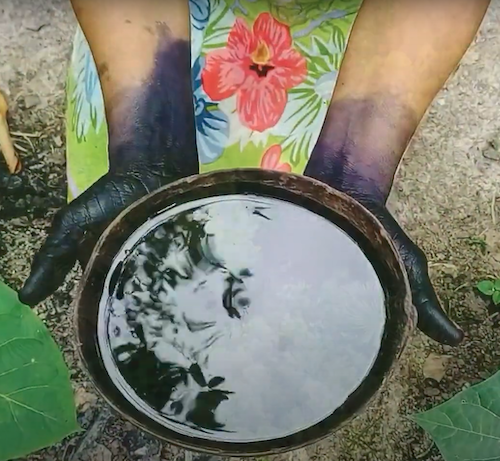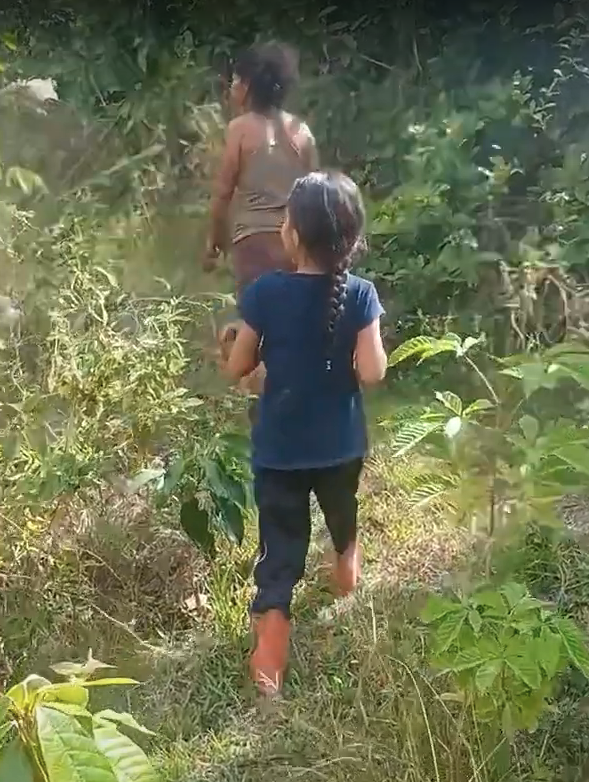languages-lifeways-connections
Nov. 20th, 2023 09:37 amIt was a peak linguistic delight to listen to a presentation, given in Portuguese by a charismatic Colombian researcher named Mayra Ricardo Zuluaga, on a film she and a Tikuna scholar (meaning, in this case, a scholar who is Tikuna) named Sandra Fernández Sebastián had made about huito (in Tikuna, é), the fruit that's so important in Tikuna culture. It makes a deep, blue-black dye, and painting this on you confers protection and blessings. It's used on babies for this purpose, and in coming-of-age ceremonies and at other important events. (And/but it can be given more casually, too: I got to grate huito, squeeze the pulp, and dye my hands with it.) The film was in Spanish, with some phrases in Tikuna.
huito/é (screenshot from the film)

grated huito/é (my own photo)

I really loved both the film (which you can see here) and Mayra's talk (which you can see here). Mayra describes going to meet Sandra with all the focus of someone educated in the European-heritage way, and Sandra got her to slow. down. The two spent time together, got to know each other, and Mayra got to learn in a different way. "Reading for the Magütá (autonym for Tikuna) doesn't begin with books, it begins with the body," she said, and "a child reads the threads of the forest."
reading the threads of the forest (screenshot from the film)

And Sandra says about maintaining the Magütá/Tikuna language, "If one doesn't talk the language, well, one loses the land,** because our mother tongue is the way we communicate with those spirits who don't speak Spanish."
Sandra harvesting huito/é (screenshot from the film)

I found a PDF made in conjunction with the film which contained contact information, so I sent a thank-you email to the two creators, and Mayra wrote back! And she linked me to more language-learning materials, records from an online class offered a couple of years ago by a French researcher. Who of course conducts the class in French! I had laugh (and thank my lucky stars I learned French in high school). A bouquet of languages to learn another language.
The butterfly is a blue morpho--if it opened up its wings, you would see the brilliant blue. And the pink wall is one wall of the Museo Etnográfico in Leticia. (screenshot from the film)

...In the European-heritage way of learning things. While meanwhile, with my friend and tutor in Leticia, we go slow, and I learn through friendly conversation. We're a continent apart, so we're not walking together, but we ask each other, "What are you doing right now?" "Numa, tacu tai cu u?" (there should be bunches of diacritics on those vowels, but my teacher is pretty haphazard about them, and I'm not sure with my ears about what they represent, so... ) or "What are you cooking?" "Tacu tai cui feim?" And then we answer each other, and we get a big laugh if we're cooking the same thing, which has happened.
**she says "territorio," but she's meaning everything that goes with territory/land: connection, sense of self, tradition, way of living.
huito/é (screenshot from the film)

grated huito/é (my own photo)

I really loved both the film (which you can see here) and Mayra's talk (which you can see here). Mayra describes going to meet Sandra with all the focus of someone educated in the European-heritage way, and Sandra got her to slow. down. The two spent time together, got to know each other, and Mayra got to learn in a different way. "Reading for the Magütá (autonym for Tikuna) doesn't begin with books, it begins with the body," she said, and "a child reads the threads of the forest."
reading the threads of the forest (screenshot from the film)

And Sandra says about maintaining the Magütá/Tikuna language, "If one doesn't talk the language, well, one loses the land,** because our mother tongue is the way we communicate with those spirits who don't speak Spanish."
Sandra harvesting huito/é (screenshot from the film)

I found a PDF made in conjunction with the film which contained contact information, so I sent a thank-you email to the two creators, and Mayra wrote back! And she linked me to more language-learning materials, records from an online class offered a couple of years ago by a French researcher. Who of course conducts the class in French! I had laugh (and thank my lucky stars I learned French in high school). A bouquet of languages to learn another language.
The butterfly is a blue morpho--if it opened up its wings, you would see the brilliant blue. And the pink wall is one wall of the Museo Etnográfico in Leticia. (screenshot from the film)

...In the European-heritage way of learning things. While meanwhile, with my friend and tutor in Leticia, we go slow, and I learn through friendly conversation. We're a continent apart, so we're not walking together, but we ask each other, "What are you doing right now?" "Numa, tacu tai cu u?" (there should be bunches of diacritics on those vowels, but my teacher is pretty haphazard about them, and I'm not sure with my ears about what they represent, so... ) or "What are you cooking?" "Tacu tai cui feim?" And then we answer each other, and we get a big laugh if we're cooking the same thing, which has happened.
**she says "territorio," but she's meaning everything that goes with territory/land: connection, sense of self, tradition, way of living.